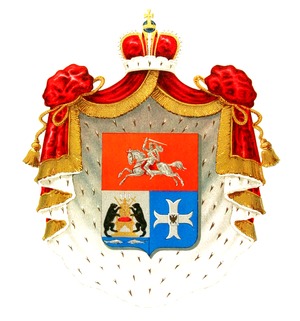| House of Golitsyn Голицыны | |
|---|---|
 | |
| Parent house | House of Gediminas |
| Country | Grand Duchy of Moscow Tsardom of Russia Russian Empire |
| Founded | 15th century |
| Founder | Andrey Andreyevich Golitsyn |
| Titles | Prince |
| Motto | Vir est Vis |
| Cadet branches | Kurakins, Khovansky, Koretsky |
The House of Golitsyn[a] (Russian: Голицыны, romanized: Golitsyny, lit. 'Galitzine')[b] is[1] the second largest and noblest Princely house in Russia.[2] Among its members were warlords, landlords, Knyaz, knights, diplomats, Prime Ministers, admirals, stewards, State Counsellors and statesmen.
The Galitzines claim their seniority in the Lithuanian dynasty of Gediminas (the Gediminids)[3][4] which has existed since the 13th century. Descendants of this family in Europe and the west write their name in the form Galitzine. The family is among the first Russian aristocratic dynasties and its members bear the honorific predicate His Serene Highness.[2][1]
The family produced many well-known statesmen and figures of the Russian Empire, among them notably Vasily, Boris, Dmitry and Nikolai Golitsyn, the last chairman of the Council of Ministers of the Russian Empire.
Numerous pieces of art or geographic locations were named after the family, such as the Galitzin Triptych created by Pietro Perugino in 1485 or the Galitzine Quartet No. 12 commissioned by Nikolai Galitzin and delivered by Ludwig van Beethoven in 1825, the Golitsyn craters A and B on the far side of the Moon, the Gallitzinberg, in Vienna, the Gallitzin borough in Pennsylvania, the Gallitzin Tunnel and Gallitzin State Forest, the Golitsyn Hospital in Moscow and various places, localities and municipalities in Russia.
Cite error: There are <ref group=lower-alpha> tags or {{efn}} templates on this page, but the references will not show without a {{reflist|group=lower-alpha}} template or {{notelist}} template (see the help page).
- ^ a b Alexandre Galitzine, The Princes Galitzine, Washington DC, Victor Graphics,2002
- ^ a b Jean-Marie Thiébaud , A great princely family of Russia, the Galitzines. Genealogy and historical notes , Paris, 1997.
- ^ Plakans 2011, p. 51
- ^ Christiansen 1980, p. 154